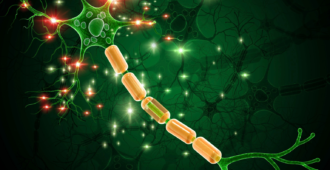Results from the UK clinical trial of diaphragm pacing in MND/ALS (known as DiPALS) were published online today in the journal Lancet Neurology.
DiPALS was the first randomised clinical trial of diaphragm pacing in MND and aimed to find out whether or not diaphragm pacing was beneficial when added to the current standard treatment of non-invasive ventilation (NIV), compared to NIV treatment alone.
The trial results unfortunately show that diaphragm pacing was not beneficial when used in addition to NIV, and was in fact harmful, with people using diaphragm pacing living on average 11 months shorter than those on NIV alone.
Breathing problems in MND
Some people living with MND will experience breathing problems. This is because MND can weaken the muscles involved in breathing leading to shortness of breath, disturbed sleep and headaches.
In 2010 the National Institute for Health and Care Excellence (NICE) recommended the use of non-invasive ventilation (NIV) in MND after it was deemed there to be sufficient evidence that NIV extended survival and increased quality of life in MND. However, NIV may not be suitable for everyone (for example people may not tolerate the mask used in NIV) and after a period of time becomes ineffective. Therefore, research into complimentary and alternative techniques to help with breathing is needed.
What is diaphragm pacing?
Diaphragm pacing works in a similar way to a heart pacemaker. However, as the name suggests, diaphragm pacing sends an electrical impulse to stimulate the diaphragm (the main muscle involved in breathing) to contract rather than the heart muscle.
Small electrical wires are connected to the diaphragm muscle during an operation under general anaesthetic. These wires are also connected to an external device that can send a regular electrical impulse to the muscle, causing it to contract. By stimulating the diaphragm muscle in this way, this technique aimed to improve respiratory function to complement NIV or as an alternative to NIV in MND.
The importance of clinical trials
Clinical trials are the gold standard for testing potential new drugs and treatments. It ensures that a treatment is both safe and beneficial before being offered to patients.
Trials of potential treatments are usually compared to a ‘control’ group, sometimes known as the placebo. This control group is essential for researchers to find out whether a treatment truly is beneficial or not. In DiPALS, the control group received the current recommended treatment of NIV.

Why DiPALS?
Lead researcher, Dr Christopher McDermott, based at the Sheffield Institute for Translational Neuroscience (SITraN) said: “We carried out the DiPALS study because breathing difficulties are a major problem in MND, especially during the later stages of the disease. Current guidelines recommend NIV should breathing difficulties arise, however we know that the benefits of NIV are limited and that NIV does not suit everyone.
“We were aware of the work in the United States on diaphragm pacing in MND and we wanted to know if it would be beneficial for our patients. Therefore we decided to design a randomised controlled clinical trial of diaphragm pacing in MND. Funding bodies like the NHS and NICE need this evidence of benefit before a treatment can be made available in the UK. Also, because it is a treatment that requires a major operation, we wanted to make sure beyond reasonable doubt that diaphragm pacing is worthwhile for patients, adding sufficient benefit such as living longer and a better quality of life.
“We established a collaboration within the MND community, including the Dementia and Neurodegenerative Disease Research Network (DeNDRoN) and the MND Association and we then applied for funding from the National Institute for Health Research (NIHR) to carry out this clinical trial. By collaborating with other UK MND Care Centres we were able to carry out a well designed clinical trial to determine if this intervention was beneficial to people living with MND.”
The results from the trial
A total of 74 people living with MND across the UK took part in the DiPALS study, with 37 being allocated NIV alone, and 37 being allocated NIV plus diaphragm pacing.
The researchers looked at the quality of life and survival rates of those who underwent the trial.
The trial results show that diaphragm pacing was not beneficial when used in addition to NIV, and was in fact harmful, with people using diaphragm pacing living on average 11 months shorter than those on NIV alone.
Dr McDermott said: “The results from the DiPALS study are incredibly disappointing, because as a researcher and an MND doctor you start out with some hope that this is a treatment that can be truly beneficial for people living with MND.
“Unfortunately, DiPALS did not show any benefits for diaphragm pacing in MND and, in fact, our study showed that it may actually be harmful. Although the results are disappointing, it was an important study to carry out as this evidence shows us that for most people there is no benefit in having diaphragm pacing and that the major surgery needed is something people living with MND should not go through.
“I am always humbled by the precious time and effort individuals give up to take part in our research studies. Those individuals who participated in DiPALS have contributed enormously to ensuring we understand the effects of diaphragm pacing in patients with MND and will ensure that we now put our focus and resources on developing other treatments that may help.”
Why are the results different to those in the United States?
DiPALS was the first randomised controlled clinical trial of diaphragm pacing looking at benefit compared to the current recommended treatment of NIV. Previous studies have not used this gold standard approach.
Dr McDermott said: “There may also be something different between our patients and those in the previous studies, although the patient population in DiPALS was representative of the MND population in the UK. We cannot rule out that in a proportion of patients that there could be benefit from diaphragm pacing or that if diaphragm pacing was started at a different time, for instance much earlier before breathing problems start, that there would be a benefit. There are studies going on in other parts of the world that may answer these questions. However the DiPALS results suggest for most patients at the time they begin to have breathing problems then diaphragm pacing should not be used.”
Lessons learnt from DiPALS
Clinical trials are in place to protect patients against potentially harmful treatments, as well as non-effective ones. As we strive for an effective treatment for MND, it is even more important that these trials are in place to allow researchers to gather high quality evidence to ensure a treatment truly is beneficial.
The DiPALS study reminds us of why clinical trials are in place, and how important it is to collect robust, reliable evidence before pursuing a potential treatment in the clinic.
Dr McDermott concluded: “MND is an awful disease and affected individuals, loved ones and the health care professionals involved in providing care, are understandably always eager to consider new treatments. It is important that new treatments are evaluated in rigorous trials to demonstrate their benefit and importantly ensure no harm is done. The result from DiPALS demonstrates that the increasing “nothing to lose” approach is inappropriate and we should not lower our standards by starting treatments without clear evidence of benefit.”
Funding: This project was funded by the National Institute for Health Research Health Technology Assessment (NIHR-HTA) Programme (project number 09/55/33) and the Motor Neurone Disease Association of England, Wales and Northern Ireland.
Find out more:
- Research Information Sheet D: Clinical trials
- Care Information Sheet 8A–E: How MND may affect my breathing and NIV
- NICE Guidelines: the use of NIV in MND
- Sheffield Institute for Translational Neuroscience (SITraN) press release
References:
DiPALS Study Group (2015) Lancet Neurology. Online First, Open Access paper. http://dx.doi.org/10.1016/S1474-4422(15)00152-0
Comment in Lancet Neurology, Hiroshi Mitsumoto. Online First, Open Access paper. http://dx.doi.org/10.1016/S1474-4422(15)00185-4






I participated in the trial and did not find it helped. I am now full time on NIV having MND for almost 4 years. It was though a good experience to be part of trial
Hi Mark, thanks for your comments about this trial and for taking part. We are pleased you found being part of it a good experience. It was an important trial to do to find the best ways to support people living with MND.
Kind regards,
Research Development Team
Why do you use both NIV and pacing at the same time? I would think that one or the other can help. Just curious as a PALS.
Dear Gudjon,
Thanks for your question. Current guidelines recommend non invasive ventilation (NIV) for people with MND with breathing problems. When the researchers designed the trial, they didn’t know what the effects of diaphragm pacing would be, so it was considered unethical to effectively withhold recommended care (by not starting NIV and only giving pacing). That’s the reason that both were given.
With best wishes,
Research Development Team
MND Association